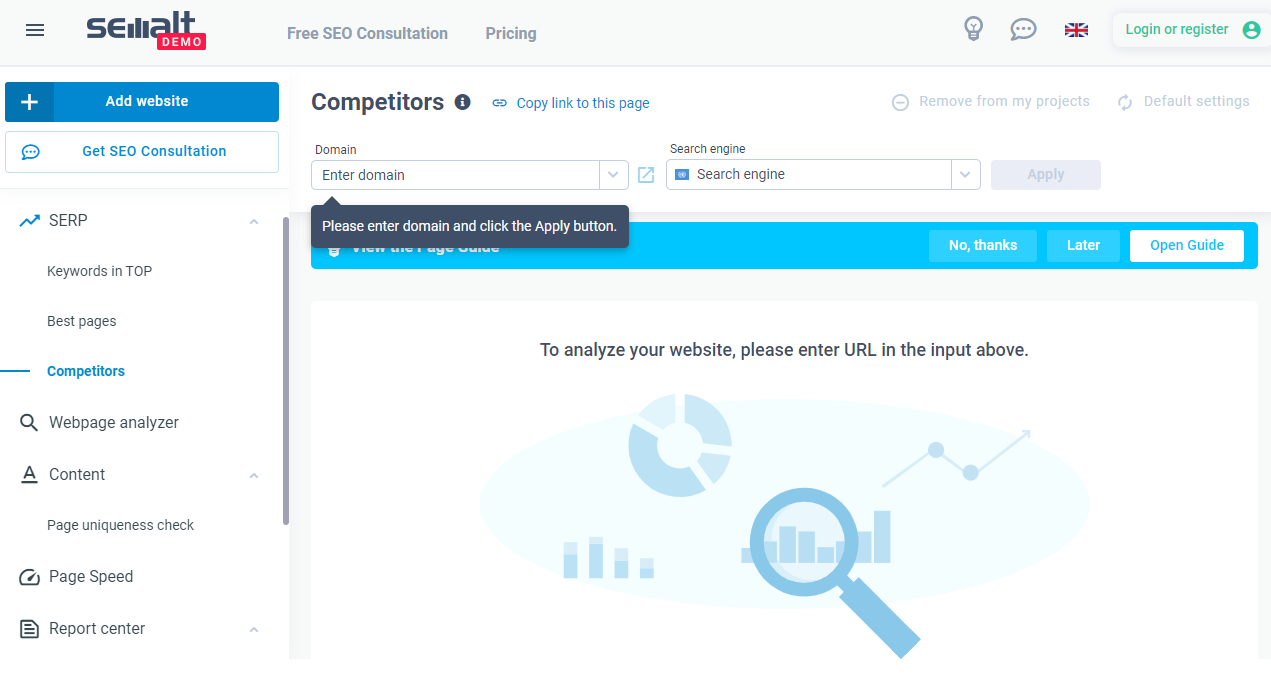Semalt: Is It Necessary To Conduct SEO Competition Analysis?

A thorough analysis of the competition precedes all business decisions. If you plan to invest in a new business, usually, your first step is to make the market search and competitive analysis.
Marketing is also a necessary activity, as it is worth knowing how the competition is advertised and trying to gain an advantage over it. As one of the elements of a long-term marketing strategy, SEO cannot be carried out in isolation from the current situation in search results.
Do you want to know what information you can obtain thanks to generally available tools? Time to read!
Competition analysis is one of the foundations of a successful SEO strategy
In addition to keyword analysis, the competition analysis should be one of the first steps after deciding to start positioning a website. Thanks to the tools available on the Internet and your own perceptiveness, you can get conclusions that it will help in SEO activities and be a guide on how to sell your offer effectively. Let's be honest, using an example - if you can see that all the competition gathered in the top ten search results has extensive offer subpages with a phone number visible at first glance, then creating a one-page page with a tiny contact form at the bottom is unlikely to help in acquiring customers. We are not talking about copying ideas here, but knowing what helps in achieving conversion - maybe, based on your own thoughts - you will be able to do it even better!
An in-depth analysis of the competition will translate into faster results - it may be possible to find a niche not fully developed by other market players and keywords that can be positioned in a relatively short time. On the other hand, however, the analysis can be a cold shower - if there are giants in the forefront, you will have a long, hard job.
How to correctly select competitors for analysis?
The analysis of competition in SEO is often pushed to the background because the thought of the type "I know my competitors perfectly - I have been in this industry for X years" appears in the head. And this is the first mistake made before we even start analyzing - why do it when everything is known?
Often, when you enter phrases related to the company's offer in Google, it suddenly turns out that it is completely different. Leading places are often taken by not local rivals whom you look at every day with disapproval and completely unknown companies that have created professional landing pages for keywords that interest your potential customers. As a result, it is not you or your competitor from the neighborhood that earns money, but a business outside the immediate area that sells the offer online and over the phone. They even travel to the customer, sometimes even several hundred kilometres, as it is profitable for both parties. This is your real competitor in search results.
In the case of stores, it can be even more difficult. Industry giants, marketplaces, and large classifieds websites, such as Allegro, Amazon, and OLX, regularly appear at the forefront of search results, as well as Zalando, Domodi, x-kom, or Empik, depending on the range of products sold. Will it be easy to jump them in the search results - definitely not! Is it possible? - Yes, but with a large budget and even more patience. However, competition analysis may show niches from which to start positioning, which will give you a chance for real earnings in a certainly shorter time than in activities aimed at competing with giants. Real competitors (at least in the beginning) will be stores that also try to develop the same niche.
The tools are good, but...
When approaching SEO competitive analysis with professional tools such as the Dedicated SEO Dashboard, you must also beware of an important pitfall. This tool is indeed a very powerful for analyzing the current state of your website and the competition. However, if your content does not describe the offer correctly, it may be that the competition in the search results is wrongly determined, as it is based on the keywords for which your website is visible on Google.

The effect very often is that the topic is omitted because "stupid things came out", and in fact, it is a very important conclusion - the problem lies in incorrect website optimization. How to analyze the competition in such a situation? You should scan the competitors' websites that are visible on Google for the phrases you are interested in. This method will also work when you are just creating your own website and are at the stage of market recognition.
I have no competition! That's great?
If your offer is so innovative and modern that it is ahead of market trends and there is no competition on the horizon… we don't have good news for you. There is a chance that a typical competitor analysis will not reveal anything. However, this is not a reason to be happy, but rather a conclusion that no one is looking for your products or services in the current form. Relax, that doesn't mean your business doesn't make sense either - it just requires a different approach. In such a situation, you should focus on the needs that your offer satisfies.
Thanks to this, you will be able to find companies that, perhaps through a different offer, but certainly, effectively reach your potential customers. Perhaps will you need to change the way your products or services are presented? Or maybe it's time for a content strategy that will show the applications of your innovations? Competitor analysis will help you answer these questions!
Basic conclusions from the competition analysis
The first, basic, and often immediately obvious conclusion from the competition analysis is the number of competitors per phrase. If there are fewer of them than on the first page of search results - maybe it looks good, but it doesn't mean it will be easy. Often, on the contrary - you can only sell from the first one or three places because the user does not see the point of clicking further. So the way to success will be getting ahead of everyone, and this can take a long time. On the other hand, if there are several dozen competitors, and the first page is occupied by the aforementioned giants, it's time to start looking for a niche and very detailed keywords.
The second important aspect in the overall assessment is the age of the top domains. Regarding the influence of domain age on its visibility, opinions vary widely, but if you see well-optimized websites whose domains are several years old, prepare for long-term, intensive SEO activities. If your competitor has been working on high positions for specific keywords for years, as recommended, it will take many months to overtake him/her. It is possible but requires patience.
Competitor keywords
Widely available analytical tools, such as the Dedicated SEO Dashboard, allow for a really in-depth analysis of the visibility of each website. As a result, we get a list of keywords for which a competitor can be found on Google, along with the position and monthly search volumes. These are estimates of course, but they can certainly be trusted, taking into account the aforementioned consideration of the method of analysis. Competitor websites are therefore a mine of knowledge on how potential customers can search for your services. On this basis, you can also create a really valuable content plan.
Backlink analysis
Another slightly overlooked element of in-depth competition analysis is a review of the profile of links leading to their websites. First of all, you will learn how many links and how many domains lead to their sites. The overall metrics of the Dedicated SEO Dashboard will also help you compare the quality of link profiles. Remember, however, that the fact that one of the domains has a higher Trust Flow or Domain Rating does not mean that it will be higher in the search results. These are comparative and may only be an indication of which direction to follow.
When browsing your competitors' links, pay attention to what type of pages they are coming from. Are they websites with sponsored articles, blogs with tips, or maybe well-known industry portals? If many of your rivals have these types of links, it is worth considering establishing similar collaborations or becoming active in the media. Does a competitor often appear on industry forums? Maybe it is worth looking for a method to reach its users.
Content and metadata analysis
With the Dedicated SEO Dashboard, you can learn the keywords leading to your competitors' websites, and even their volume or where the competitors are displayed. However, the question arises - where did these items come from? It is at this point that a detailed overview of the individual websites begins.
A few basic elements that are worth paying attention to when analyzing the competition are:
- website structure (subpages, menu structure);
- header structure;
- the length of the content and how often keywords appear in it;
- construction of metadata.
Find out which elements of your competitors' offer have separate subpages, what their URLs, metadata, and header structure look like. Pay attention to how they are described as well as how rivals use the keywords you are interested in. Do they have a blog? What content is published on it? It sounds like a plan for long and arduous work, but it will give you many valuable lessons.
Technical aspects of the site

Technical issues in competition analysis are elements bordering on SEO and UX.
Google robots try to imitate users' behavior. Therefore, if there are visible flaws on the page, search engine crawlers will also notice them.
The first aspect is the page loading speed. There are huge differences of opinion about its impact on SEO, but the update linked to the new Core Web Vitals in mid-2021 makes it clear: A page that loads efficiently, whose interface is displayed correctly on any device, is smaller or larger in the Google evaluation. This doesn't mean you have to fight competitors for fractions of a second, but it's not worth being visibly weaker. Even the most beautiful page, if it takes a few tens of seconds to load, will scare potential customers away. The Dedicated SEO Dashboard tool will certainly help you in this analysis and give you suggestions to improve this parameter of your site.
Another interesting feature is internal linking. Pay attention to how the menu of the competition's website is structured and what elements are available after 1-2 clicks. Also, take a look at the links between listing pages and blog articles.
Of course, these are not the only technical aspects of competition analysis - they can be classified as basic and should be checked first. It is also worth taking a look at the technologies used, as they can affect the effectiveness of marketing campaigns.
Competition analysis is not only SEO...
By looking at the structure of the website, the content available on it, and the technologies implemented, you can draw many more conclusions than those that will help you in positioning activities. An in-depth analysis of the competition allows you to define the method of presenting the offer, encouraging conversion, as well as the communication strategy with the client. In addition, nothing prevents you from getting to know the shopping path and additions to the site that indicate the use of marketing activities in other channels.
Competitor analysis is done - what next?
After a thorough analysis of the competition and comparing it with your (existing or emerging) website, you probably have a long list of applications. So the question probably arises - what to do next? You should implement solutions not identical but rather better than on the competitors' websites. If you provide your users and robots with the same things as your rivals in search results, you have little chance of appearing higher than them on Google.
At this point, your company's expertise plays an important role. If you have your own SEO specialists and other online marketers, they will surely know what changes are worth introducing. If not, you can always use the help of our Internet marketing agency.
The results of the competitive analysis are therefore an important basis for determining the budget needed for effective SEO activities.
Conclusion
Competition analysis in SEO is a complex and very difficult task for many. By approaching it in an orderly manner, with a "search plan", you can draw conclusions that will not only help in website positioning, but also other marketing and business activities.
If website positioning is a big challenge for you, and you know that it can be a source of valuable traffic and many conversions - check out our offer. We have been in the industry for years and we know how to do it!

